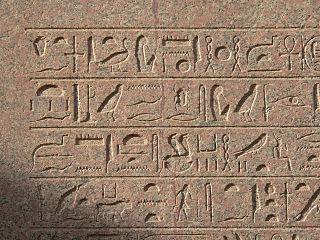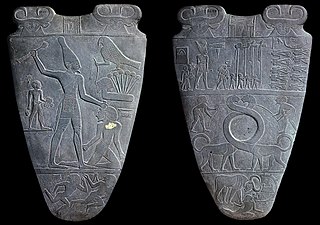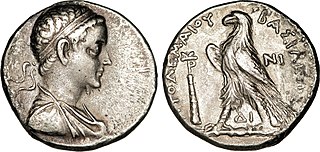
Deshret, from Ancient Egyptian, was the formal name for the Red Crown of Lower Egypt and for the desert Red Land on either side of Kemet, the fertile Nile river basin. When combined with the Hedjet of Upper Egypt, it forms the Pschent, in Ancient Egyptian called the sekhemti.
A Hand drill is a hieroglyph,, used in Ancient Egypt from the earliest dynasties. As a hieroglyph, it can also be used as a determinative for words related to the profession of vase, bowl, pot-making, etc., typically from fine-grained, colorful rare stone, for example unguent jars. The size of drills was small-to-large, small for small unguent jars, and large for more massive, grain-storing pottery. The original jars found in tombs were more often used for ceremonial usages, presumably the reason they are found as grave goods or tomb offerings.

The ancient Egyptian ship's mast hieroglyph is one of the oldest language hieroglyphs from Ancient Egypt. It is used on a famous label of Pharaoh Den of the First dynasty, but forms part of the location hieroglyph: Emblem of the East.

The ancient Egyptian Man-prisoner is one of the oldest hieroglyphs from Ancient Egypt. An iconographic portrayal from predynastic Egypt eventually led to its incorporation into the Egyptian language. Not only rebels from towns or districts, but foreigners from battle were being portrayed.
The ancient Egyptian Hand (hieroglyph) is an alphabetic hieroglyph with the meaning of "d"; it is also used in the word for 'hand', and actions that are performed, i.e. by the 'way of one's hands', or actions.
The ancient Egyptian Man-seated: arms in adoration hieroglyph is one of a series of language and visual hieroglyphs used from the earliest dynasties of Ancient Egypt, and that portrays men, women, ideology, and some occupations.
The foreleg of ox hieroglyph of Ancient Egypt is an old hieroglyph; it even represented a nighttime constellation. It came to have many uses in Ancient Egypt over three millennia.
The Throw stick hieroglyph of Ancient Egypt is an old hieroglyph that dates from the Predynastic Period; it is from the assemblage of hieroglyphs used on the ornamental, or ceremonial cosmetic palettes. It is used on the palettes both as a throwing-stick weapon in the animal hunt being portrayed-(the Hunters Palette), as well as on certain palettes, as a determinative referring to a "foreigner", or "foreign territory".
The ancient Egyptian papyrus stem hieroglyph is one of the oldest language hieroglyphs from Ancient Egypt. The papyrus stalk, was incorporated into designs of columns on buildings, also facades, and is also in the iconographic art portrayed in Ancient Egyptian decorated scenes.

The ancient Egyptian Bowstring hieroglyph is an Egyptian language hieroglyph associated with the bow, and its use as a hieroglyph for the Archer hieroglyph, a symbol for 'army'. Because of the strength required to "string a bow", with a bow string, the bowstring hieroglyph is used to define words of strength, hardness, durability, etc.

The ancient Egyptian Bone-with-meat hieroglyph represented: "ancestry, inherit", and phonetic isw, iw' ; a determinative for the femur, (iw'); and swt, for the tibia.
The ancient Egyptian child hieroglyph is part of the Egyptian Gardiner's Sign List hieroglyphs for the beginning core subgroup of Man and his Occupations. It relates to the child, and childhood, and has a version for the Pharaoh, as a child.

The Ancient Egyptian Townsite-city-region (hieroglyph) is Gardiner sign listed no. O49 for the intersection of a town's streets. In some Egyptian hieroglyphs books it is called a City Plan.
The Ancient Egyptian Brazier hieroglyph is Gardiner sign listed no. Q7 for the cooking brazier. It is shown from the Old Kingdom in the style of a vertical burning flame upon four feet, but the hieroglyph has the flame hiding the fourth foot. Another Gardiner unlisted form has the four feet, with no flame, and in a plan view.
The Ancient Egyptian Swallow hieroglyph is Gardiner sign listed no. G36 for swallow birds. The Sparrow hieroglyph appears similar in size and shape, but it is used to represent small, or bad items.
The grape arbor hieroglyph is used in Egyptian hieroglyphs as a determinative, or ideogram for words related to the "vineyard", i3rrt, or for 'wine', irp; it is also used for describing 'fruit' or 'orchards'.

The ancient Egyptian Two Whips with Shen ring hieroglyph, Gardiner sign listed no. S23 is a portrayal of the Shen ring with two Egyptian flails-(Crook and flail); it is a member of the Gardiner subset for "crowns, dress, staves, etc".

The Egyptian hieroglyph ndj (nḏ) has the shape of a "cross". It presumably depicts some type of tool, such as a "mill". It is often written alongside the nu "pot" hierogplyph (W24). It is used as an ideogram or determinative in the context of "grains", "grinding stone", "grind", "to rub out".

The ancient Egyptian Arms-in-embrace hieroglyph, Gardiner sign listed no. D32 is a portrayal of the embracing human arms. The hieroglyph is in the large Gardiner sign list category of Parts of the Human Body.

The ancient Egyptian Bull (hieroglyph), Gardiner sign listed no. E1, is the representation of the common bull. The bull motif is dominant in protodynastic times, and also has prominence in the early dynastic Egypt, famously on the Narmer Palette. Its phonetic value is kꜣ.



















